Court complete candour - Learn-it-all not know-it-all - Quality objectives - Independent review - Not a self-congratulatory exercise - Trend spot and correct - Consistency is king - This is not a marketing practice - Another row for your toolbox!
In last week’s blog, I talked about capability transfer as an expected client-benefit of most professional service engagements. The topic triggered me to talk about client feedback generally (did you achieve what you set out to deliver?) and it is to this essential practice I turn to now.
Client feedback
Once your professional business is up-and-running and early client projects being won (see blog series on selling if not at this stage yet), you need to ensure that your expertise and services really do match the claims you make (i.e. align to the unique value proposition your website and corporate literature extols).
Let me first make the point about attitude. To not regularly court candid feedback from your clients indicates one or more of these qualities in your business: hubris, know-it-allness, inexperience or laziness. Conversely, the best firms I see have an ethos of aiming for excellence coupled with the humility to know they will never quite get there – eminence lies always a little further. Such firms have what Professor Carol Dweck describes in her excellent book of the same title, a growth mindset or a learn-it-all mentality.
I implore you to be such a firm and it starts with this attitude – as set from the top. To succeed and grow you have to be in a perpetual state of improvement, always looking at areas to improve your services, the consistency of your delivery and the value you, ultimately, bring to bear. You can only do this by systematically taking client feedback and acting intelligently upon it (more on which later).
So, let’s explore how this might best be done in actual practice.
Please send me
My example client feedback scorecard

Firstly, to say, that client feedback will invariably be a core component of your quality management system (QMS). Even if you don’t have a regulated QMS (such as ISO 9001), an established client feedback process will essentially act as the backbone to any such management system.
Within a QMS based approach you can set whatever quality objectives you so seek; the critical point is not the objective(s) per se but rather the fact that you have a systematic approach to: setting service-related goals, to comparing actual results to these target objectives (to track variance) and then to action planning required resolution and improvement.
That said, I am sure you have premier firm standards and ambitions, so a key quality objective might be:
To always achieve an Expectations Met rating from our client at the end of each engagement on the engagement scorecard (and to exceed expectations often).
It is important to set such objectives, as the first step in this process, in order to give your client feedback important context and reference.
Once these objectives are set, you should next turn to how this fits into your client engagement process generally. This will, of course, depend on your average engagement size and length but, as an example, the protocol below might suit a firm that typically embarks on multiple-month engagements.
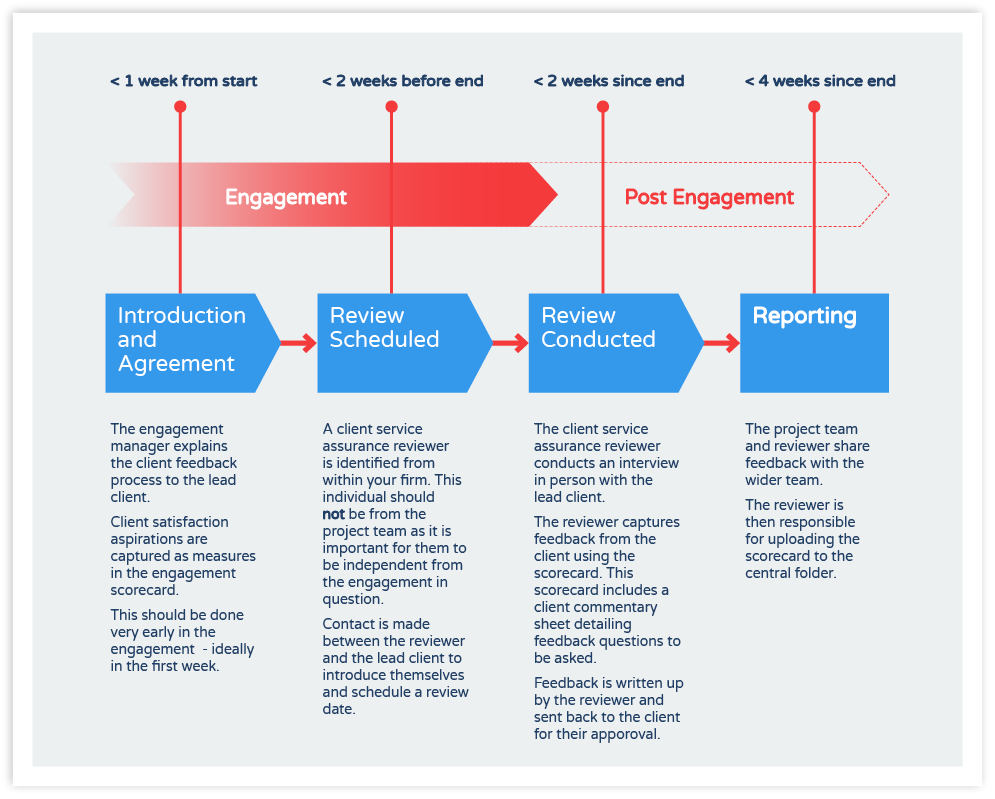
Figure: Example client feedback protocol
Whilst this process needs to be bespoke to your type of engagement, there are some generic best practice principles.
Firstly, it is important to explain and initiate the process to your client at commencement of your work. Ideally, the scorecard should contain both a fixed element (common aspects of performance that you seek to track consistently across time and across multiple clients) and aspects that are specific to, and requested by, your client.
For example, a transformation-focused consultant may track the following constants:
- Delivery to time
- Delivery to cost
- Delivery to scope/quality
- Proposed business benefits delivered
- Consultant to Client capability transfer (see blog)
In addition, the scorecard should allow for the client to specify their important objectives and, ideally, to weight the relative contribution of all of these components. The simple scorecard below illustrates:
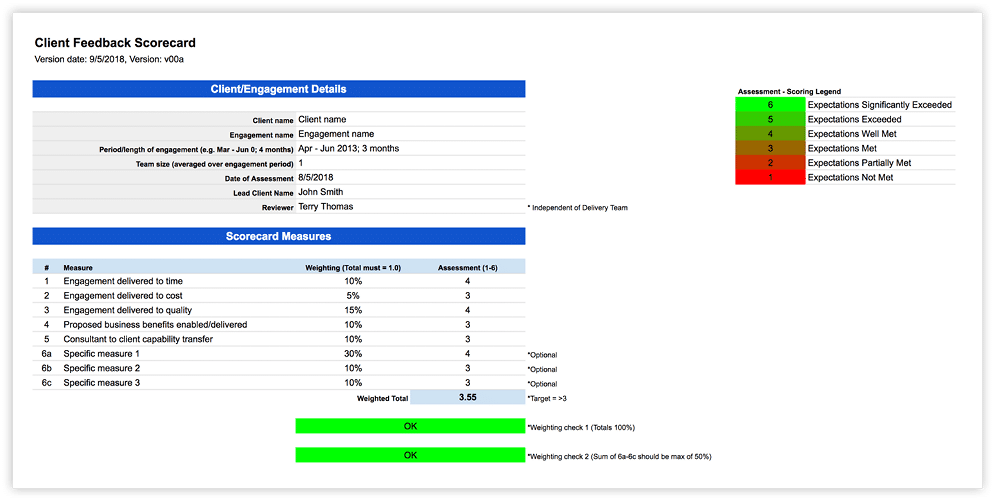
Figure: Illustrative client feedback scorecard
As well as capturing quantitative data (that can be assessed against a quantitative objective) a scorecard should also allow for open, qualitative feedback. The downloadable example (see box below) illustrates.
Please send me
My example client feedback scorecard

Secondly, the actual feedback review should be undertaken by someone independent of the actual delivery team. In your early stage, with perhaps only a few people in the team, this can be challenging but I would really encourage you to seek this independence (possibly using someone from outside your firm). This is critical with respect to giving your client more space to be constructively honest in their comments.
Thirdly, I would encourage you to make this process as easy for busy clients as possible. If you have been involved in a multiple week engagement then it is very reasonable to expect a face-to-face c. 30 minute meeting with a lead client on completion to carry this out. Indeed, for really long engagements, you might expect to do this every 3-6 months. Conversely, if your engagements are much shorter this might be a telephone call or a simple web-form to complete. Whatever the means, you should emphasise upfront the importance of this component within your overall service description (most clients will be very happy to support) and make it as effortless as possible for them. For example, busy clients may prefer a telephone call that you write-up (and then check back the transcript notes with) than a long form to complete.
Finally, what you do with this client feedback is what really separates out successful, evolving firms from the mediocre, static masses; so, this aspect deserves breaking down further.
I would encourage you to play back all results to your entire team at regular intervals – say every quarter. The key principle of high-performing teams is that such data is reviewed honestly and not just as a self-congratulatory exercise. You certainly shouldn’t seek to massage the data – or – skim over any negatives. The point is to celebrate success of course but, also, to obsess about what you can do to rectify any systematic weak areas in your delivery. In the example below (perhaps presented as a slide at your quarterly gathering) whilst the firm’s overall quality objective is being met – this analysis should preempt discussion as to why the slide downwards in recent quarters? Is the greater number of engagements dampening down the results (team spread too thin)? What interventions/training can help correct this trend?
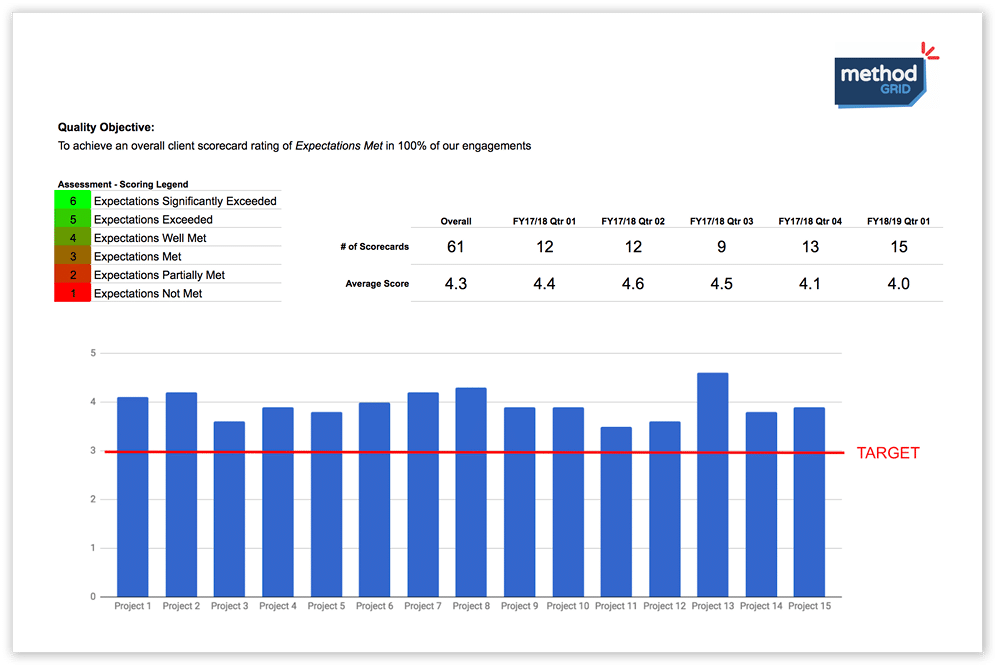
Figure: Illustrative (regular) summary of client feedback scorecards
You will also want to track all of your client feedback over time (see below chart as illustration). One of the most important qualities of premier professional service companies is consistency in delivery. This is achieved by companies who invest in the development of their service methodologies, staff training and quality assurance systems – such that any negative trends get quickly spotted and corrected. You seek to have a team all working over a de minimis level of technical and service quality as opposed to a wide spread between your superstars and under-performers. Nothing will kill a professional service brand quicker than a reputation for hit and miss delivery.
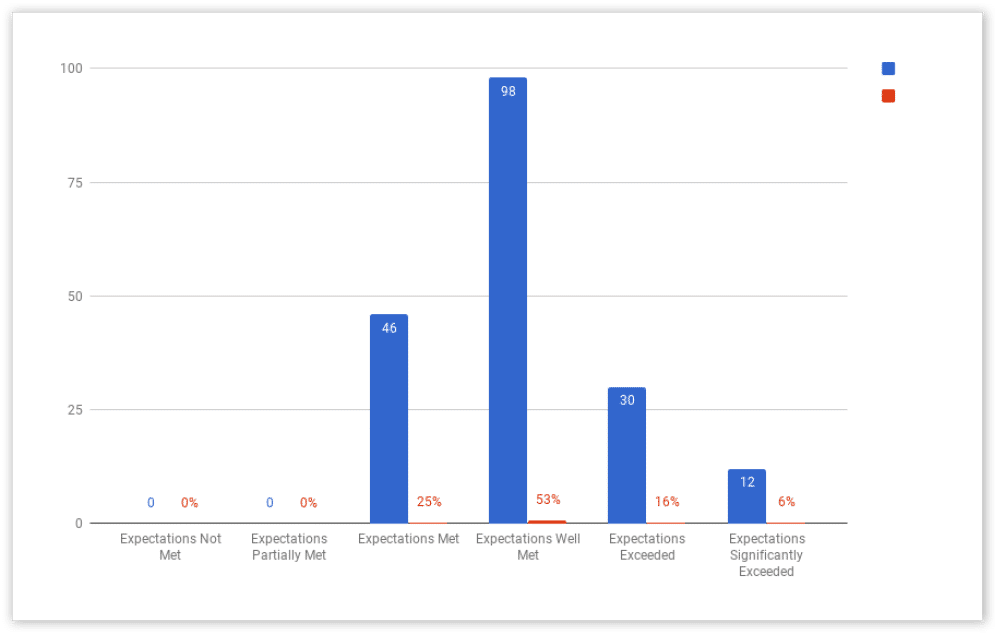
Figure: Track delivery consistency
Finally, an important message about using such feedback in your marketing. If you are able to produce aggregate data as per graph above you are entitled to shout about the “we consistently meet client expectations” point – it will be a genuine differentiator. Occasionally, also, you may receive such a great piece of commentary back (e.g. “Delighted with the team from [X]. They took a huge weight off my shoulders”) that you might ask permission to reproduce. The emphatic point, however, is that client feedback is fundamentally not a marketing exercise; rather, it must be fixated totally on your desire to manage a consistent, quality service. Any marketing collateral gained is but the rare fortunate aside in this undiluted exercise.
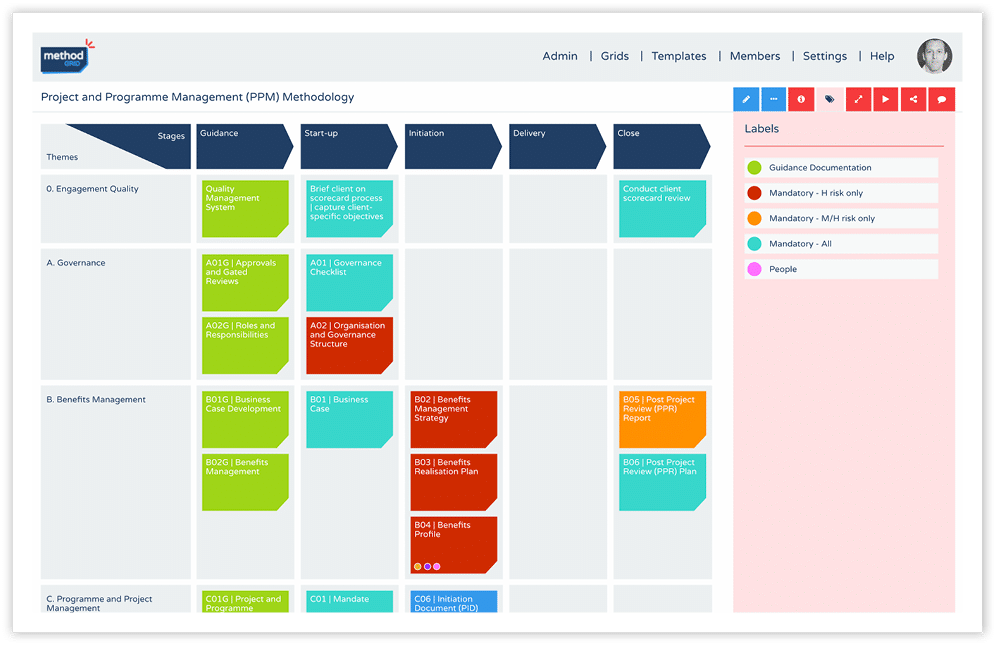
Figure: Embed client feedback into your standard engagement management practices
So, if not already in place, this essay has, hopefully, inspired you to develop your own quality objectives, develop a simple scorecard mechanism and to embed the process of client feedback into your engagement management practices.
So, what’s next?
Next week, as triggered by reader request, I am going to take a look at the question of how to best identify and develop your senior team in a professional services business.
Hopefully, you’ll join us on this journey. It’s totally free, and you don’t have to be a Method Grid customer (though you’re more than welcome to sign up for a free trial here).
We’ll be releasing a new post each week. To get each post emailed to you as soon as it’s published, sign up for the Climbing Mount Audacity mailing list below.
Climbing Mount Audacity…
From Startup to Scaleup!
We're sharing everything we know about how to build an awesome professional service firm (and enjoy the journey en route!) PLUS travel updates, reflections on our stumbles and general musings on our Method Grid journey.
Signup below to get the latest articles
direct to your inbox.
See you next week. Have something you want to hear more about? Let me know in the comments below or via Twitter.

 Project and Program Management
Project and Program Management  Project Governance Framework
Project Governance Framework  Benefits Management Framework
Benefits Management Framework 






